Indoor Hanging Plants: Easy to Care for Hanging Houseplants (With Pictures)
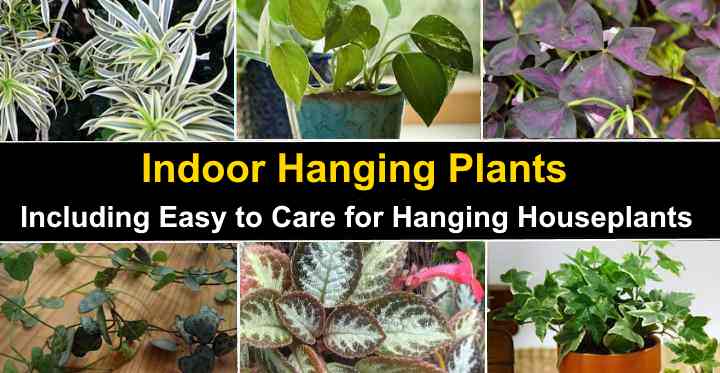
Indoor hanging plants with dangling stems are excellent for creating vertical greenery in your home. Trailing houseplants, vines, and indoor climbing plants sit well on shelves, windowsills, or suspended from the ceiling. Many types of hanging house plants grow well in low-light conditions as long as they get high humidity and regular watering. Whether you want to grow hanging plants in the shade or a sunny spot, there is a perfect draping plant for you.
The best indoor hanging plants that are easy to care for include English ivy, trailing peperomia jade plants, heartleaf philodendrons, and arrowhead plants. These trailing houseplants provide lush green foliage in almost any room. The best indoor low-maintenance hanging basket flowers are lipstick vines, goldfish plants, and chenille plants.
In this article, you’ll learn about the best plants for hanging baskets indoors. And, not just the best ones, but cascading plants that are easy to look after. At the end of the article, find out how to care for your trailing indoor plants to make them thrive.
How to Choose Indoor Hanging Houseplants
Indoor hanging plants should be trailing, climbing, or vining plants that don’t have a lot of care requirements. Most indoor hanging houseplants require bright, indirect sunlight. However, some shade-loving cascading plants are excellent as bedroom plants or shower plants where light tends to be limited.
Long hanging plants are excellent to bring life, beauty, and greenery to any room. Bushy, trailing ivies can help to fill space when their foliage drapes down over empty spaces. Or, vine plants with thin stems and delicate leaves can complement any modern, minimalistic décor.
The Best Indoor Hanging Plants (With Pictures)
Let’s look in more detail at the best hanging plants for indoors that look great in hanging baskets or pots placed in high places.
Indoor Ivy Plants for Hanging Baskets

Ivy plants are some of the most popular hanging houseplants for sunny spots or shade. Indoor ivies grow exceptionally well in various indoor locations such as windowsills, on high shelves, tall plant stands, or in hanging baskets. Trailing ivy plants are so easy to look after indoors that you only have to water them when the soil is partly dry.
Ivy plants are long hanging plants, so make sure you’ve got plenty of room for their stems to dangle.
Here are some of the best green ivy plants for indoors:
- English ivy (Hedera helix)—This is a fast-growing evergreen vine that has leaves in the shape of a duck’s foot. Variegated foliage helps to brighten up shaded corners of your room. The ivy grows best in bright, indirect sunlight.
- Algerian ivy (Hedera algeriensis)—Long, trailing green foliage characterizes this indoor hanging plant. This ivy plant looks similar to English ivy, only with larger leaves.
- Persian ivy (Hedera colchica)—Variegated varieties of this ivy are popular indoor hanging basket plants. The bushy foliage with large green and white leaves looks elegant, draping down from the pot.
Golden Pothos Hanging Plants
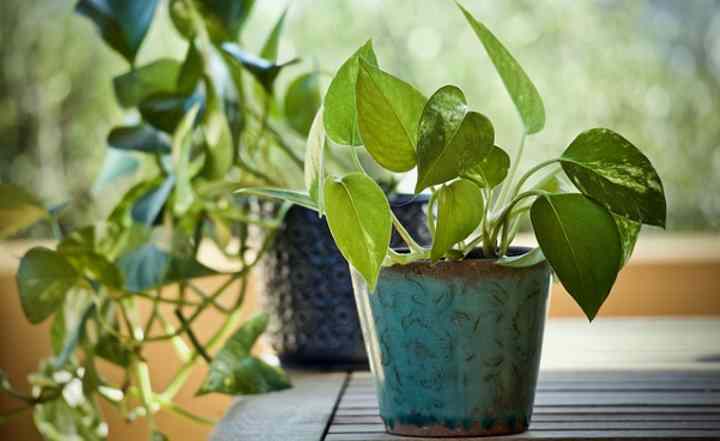
Golden pothos (Epipremnum aureum) is a favorite indoors hanging plant because it is easy to care for. Also, its brightly-colored green and yellow foliage helps to brighten up dim corners or dark spaces. Even though these are flowering plants, they rarely bloom indoors.
This decorative tropical houseplant can grow trailing stems up to 6 ft. (2 m) long indoors. To care for this easy hanging plant, water it when the soil feels dry to touch. Even in dark conditions, pothos grows well; however, it may lose some vibrancy from its foliage without enough light.
Grow in a trendy macramé hanger and hang from a ceiling or a shelf to enliven any room.
Spider Plants (Chlorophytum comosum)
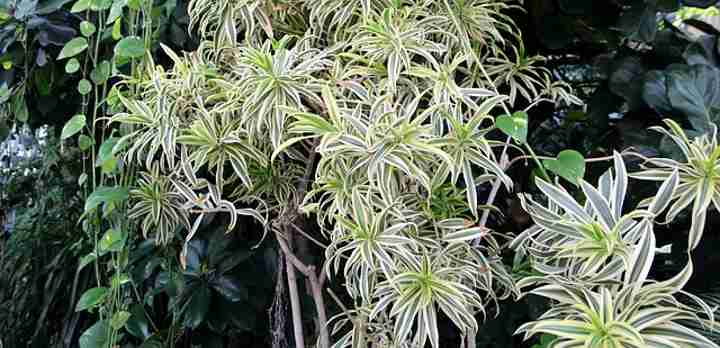
Spider plants are great houseplants for hanging baskets because they can put up with a lot of neglect—they are drought-resistant plants that survive dark conditions. The long arching, tapered leaves give the plant a spiky appearance. The most common types of these easy house plants have variegated ribbon-like leaves with green and creamy-white colors.
An unusual feature of spider plants is their long stems that produce “babies.” Tiny mini-spider plants grow at the end of these dangling stems. You can snip them off and plant them in pots to propagate them.
Another benefit of having spider plants in hanging baskets is that they are on the list of clean air plants that remove toxins from the air in rooms.
Trailing Jade Plants (Peperomia rotundifolia)
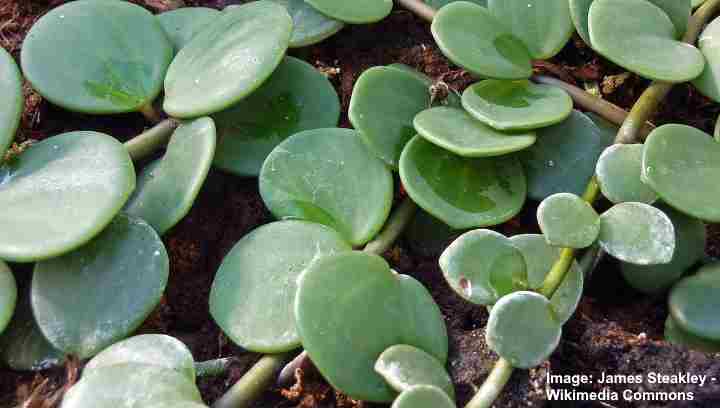
In the picture: Peperomia rotundifolia ‘Trailing Jade’
Trailing jade plants are one of the prettiest hanging house plants to grow indoors. The cascading stems elegantly beautify shelves, hanging basket, or tall planters. Their small round green leaves are slightly curved, adding to its intrigue as a delightful indoor plant.
To care for ornamental trailing jade plants, keep humidity high by regularly misting. Place in a bright spot but away from direct sunlight. The most critical care requirement is proper watering—only water when the soil is partly dry.
Many types of peperomia plants are shade-loving plants that are excellent for hanging baskets. Some peperomia cultivars have trailing vines and leaves with fascinating ornamental foliage that adds visual interest to your room. Varieties of these hanging house plants have textured leaves, smooth glossy leaves, or leaves that look like watermelon skins.
Heartleaf Philodendron (Philodendron hederaceum)
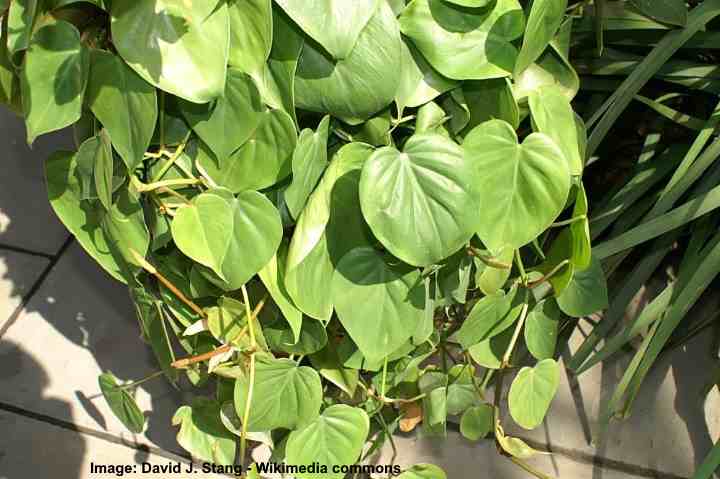
Heartleaf philodendron is another trailing vine plant that isn’t fussy about how you look after it. As its common name suggests, this evergreen tropical plant has heart-shaped, glossy green leaves. If you want the long stems to grow, avoid pruning the plant. In time, the trailing leaves will cascade down from a hanging basket, shelf, or bookcase. Place the hanging plant about 3 or 4 ft. (1 – 1.2 m) high to give the vine enough room to dangle.
This easy-to-grow hanging house plant needs watering only when the soil is partly dry. Occasional misting will help meet its humidity requirements, and you need to keep the plant in a bright spot.
False Shamrock (Oxalis triangularis)

False shamrock is an unusual hanging house plant due to its deep purple-maroon foliage. The mound of dark purple leaves grows so bushy that the leaves start to spill over the side of the pot. These eye-catching plants require minimal attention to thrive indoors. They need partial shade, well-drained fertile soil, and occasional watering to keep the purple-black foliage looking healthy.
Similar to prayer plants, false shamrock’s leaves close in the evening and open in the morning.
Satin Pothos (Scindapsus pictus argyraeus)
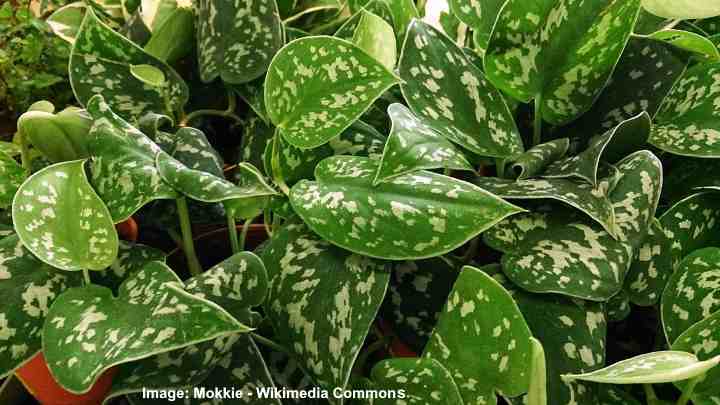
Satin pothos is one of the easiest hanging houseplants to look after indoors. They are so non-fussy about how you care for them that they are classed as “plants you can’t kill.” This trailing plant has large green variegated leaves with light green or cream specks. Keep in bright sunlight to maintain vibrancy in the leaves.
This humidity-loving houseplant is also a great plant to add to closed terrariums.
Goldfish Plant (Nematanthus)
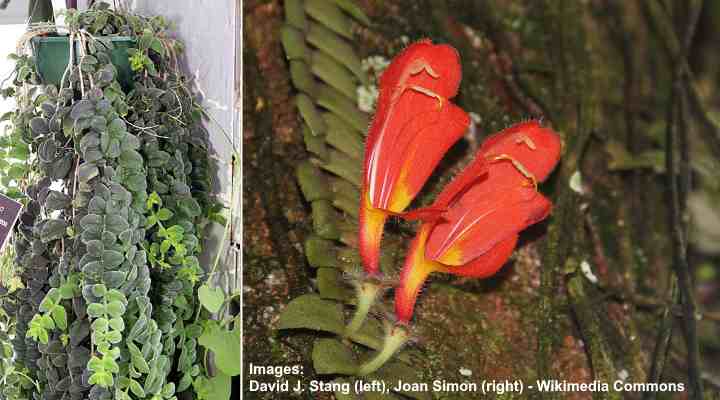
Goldfish plants are one of the prettiest hanging basket flowers that love dappled shade. Their delightful orange-reddish blooms and shiny rich green foliage are the outstanding qualities of this enduring draping indoor plant. You can place the potted flowering plant in a shaded area as long as the room is generally bright.
Due to its compact growth, the goldfish plant is perfect for hanging in small kitchens, in bright bathrooms, or other bright spots where space is limited.
String of Pearls (Senecio rowleyanus)
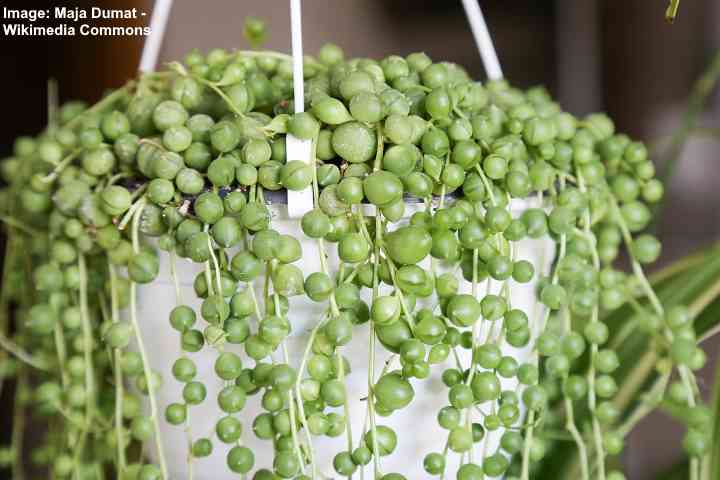
Also called string-of-beads, string-of-pearls is a trailing succulent plant with thin, thread-like stems and leaves that look like green peas. The strings of pearly stems cascade over pots and hanging baskets, giving the appearance of a green waterfall. These cool hanging plants are easy to grow indoors in bright, indirect sunlight with occasional watering. In fact, the string-of-pearls is a hanging plant that seems to thrive on neglect.
String-of-pearls can grow as a display plant in hanging baskets, or you can grow other flowering plants to add interesting layers to your hanging display.
Burro’s Tails (Sedum morganianum)

Another succulent plant with long trailing stems that thrives indoors is burro’s tails—also called donkey tails. The dangling stems have small, plump, succulent leaves that are a bluish-green color. One of the interesting features of the cascading stems is the way they look woven or plaited.
Long vertically hanging “tails” can reach up to 2 ft. (60 cm) long, so you have to place them high up from the ground. The best location for these hanging flowering plants is in bright sunlight. Water only when the soil is dry.
Lipstick Vine (Aeschynanthus)
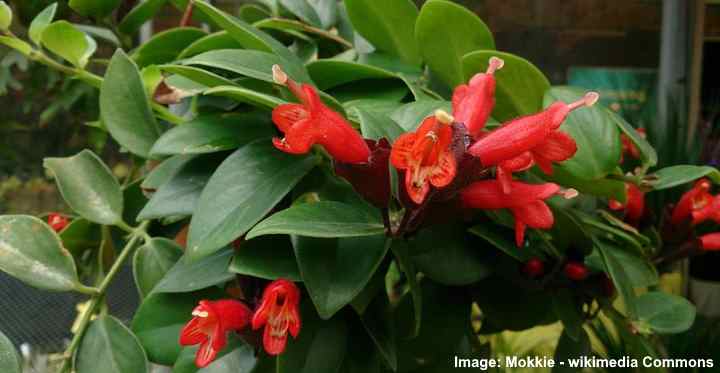
Lipsticks vines are flowering plants for hanging baskets that produce beautiful red, orange, or pink blooms in winter. These houseplants are excellent if you need shade-loving plants that produce flowers indoors. As the leafy stems grow longer, they drape down from baskets or pots. The orangey-red flowers grow upward, giving the plant an attractive decorative appearance.
The best growing container is a hanging basket to give the cascading waxy stems room to grow. They are quite fussy plants that need bright light, plenty of humidity, and moderate watering. Make sure to read our article about caring for lipstick vine plants.
Arrowhead Vines (Syngonium podophyllum)

Arrowhead plants are long vines that produce beautiful foliage with large green leaves. The common name comes from the shape of the leaves that look like arrowheads. If you want to grow this plant in hanging baskets, avoid pruning the stems so that the plant hangs down to the ground. The long hanging stems can reach up to 6 ft. (1.8 m) in length.
You can grow arrowhead plants in a shady location where sunlight is minimal. However, to care well for the vining plants, keep them in a bright place with filtered sunlight. Water moderately and maintain high levels of humidity.
Chenille Plant (Acalypha hispida)
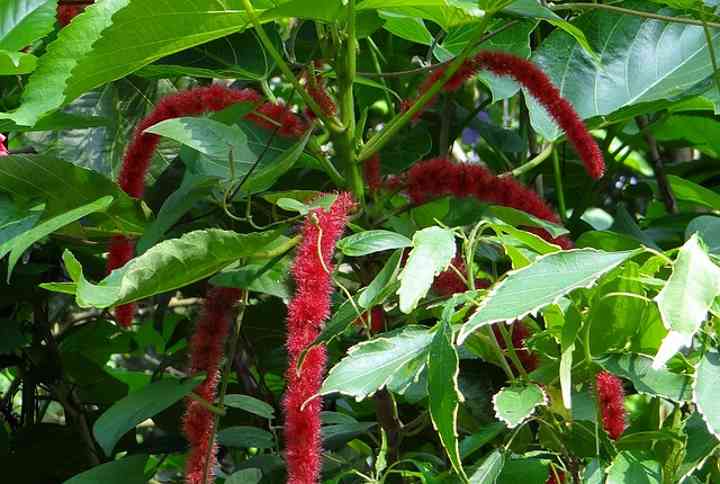
Chenille plants have weird-looking flowers that dangle down longer than the leafy green foliage. The fuzzy red pendent flowers look like thin pipe cleaners or cat’s tails that arch and hang down. The botanical name for this plant means “bristly,” referring to the brush-like flowers.
To enjoy the fascinating hanging flowers, place the hanging basket in a bright, sunny location. You will need to provide plenty of water to keep the soil moist and mist the leaves—not the flowers—to keep up humidity. Just remember that all parts of the plant are poisonous, so suspend the plant high up or place it on a high shelf away from children, cats, and dogs.
Maidenhair Fern (Adiantum)
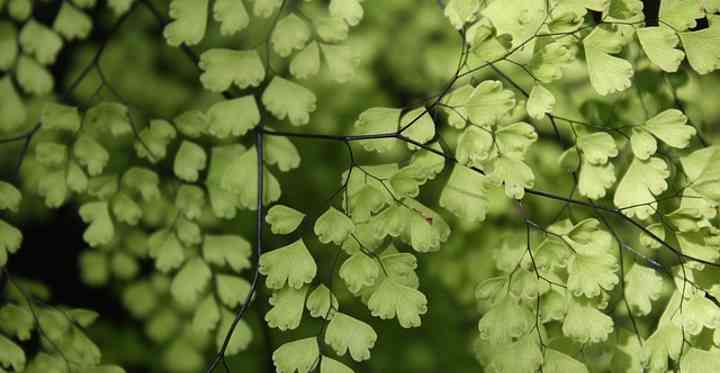
One of the best ferns to keep indoors in a hanging basket is the maidenhair fern. This leafy green plant has delicate feathery foliage that grows upward and then cascades over the side of pots. These hanging plants grow well in shaded locations as long as they get moist soil and are kept away from drafts.
The long trailing fronds with their bushy appearance are excellent to fill an empty space.
Pitcher Plant (Nepenthes)

The only way to grow pitcher plants indoors is in hanging baskets. Climbing stems produce large sword-shaped leaves that give an aesthetic quality to any modern décor. However, the exciting feature of these tropical houseplants is the “pitchers” dangling at the ends of thin stems.
These pitchers are traps that the carnivorous plants use to trap their prey. When a fly, spider, or gnat gets in the pitcher, the lid closes, and the plant enjoys its tasty meal. Keep these plants in bright light with moist soil. They may even help reduce the number of plant bugs in your home.
String of Hearts (Ceropegia woodii)
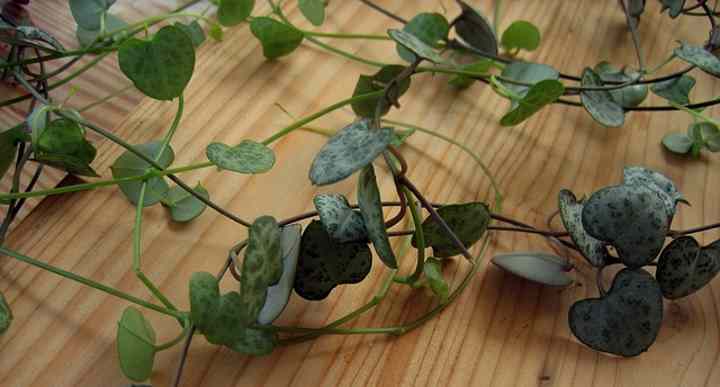
String-of-hearts is a compact hanging plant, perfect for small spaces if you want to create a vertical garden. Also called a rosary vine or chain of hearts, the thread-like delicate vines have variegated leaves in the shape of a heart. When growing in bright, indirect light, the leaf colors intensify to develop deep green and purple patterning.
The essential care requirement for these green and purple hanging plants is to avoid excessive soil moisture. Only water when the potting mix is dry, and keep out of direct sunlight.
Mistletoe Cactus (Rhipsalis baccifera)

Few cactus plants are suitable for hanging baskets, but the mistletoe cactus is one of them. This succulent plant has thin pendant stems that dangle vertically down, reaching lengths of up to 6 ft. (1.8 m). This ornamental cactus has a bushy appearance before the smooth green stems grow longer. The trailing succulent stems will then drape down over the container providing a green waterfall effect.
To care for a mistletoe cactus, keep in bright, indirect sunlight—the best is morning light when shaded from midday and afternoon sun. Water when the soil is partly dry, but avoid over-watering or under-watering.
Staghorn Fern (Platycerium)
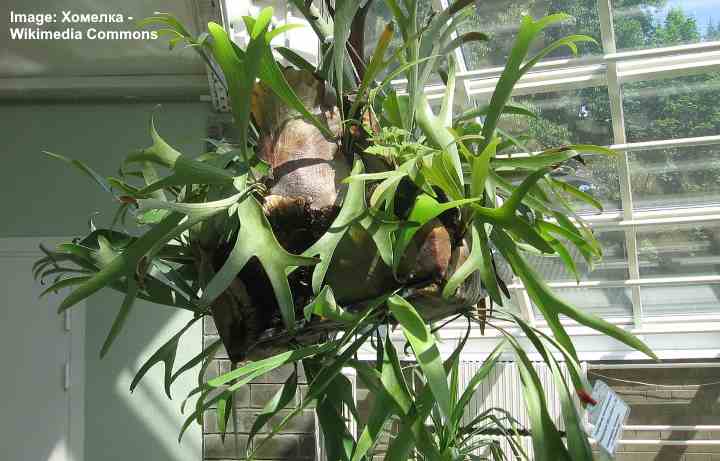
In the picture: Platycerium bifurcatum
Staghorn ferns are one of the most unusual non-flowering hanging plants that you can grow indoors. The plants don’t look like a typical fern as the leaves are broad and smooth. Because these plants are epiphytes—they take moisture and nutrients from the air—you can hang them in several different ways.
For example, you can mount these ferns on boards or plaques or hang them in wire baskets with sphagnum moss. Their foliage looks like deer antlers or caribou horns that create an instant talking point for your visitors.
Flame Violet (Episcia cupreata)
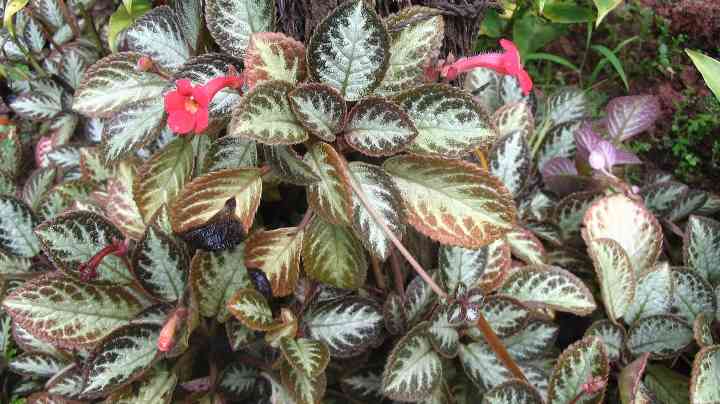
Flame violets are a spreading type of plant which makes them perfect as a flowering plant for hanging in baskets or suspending from shelves. The plant has attractive green, ovate leaves with vein-like patterns. Flame violets also produce dainty red flowers when they bloom. Some cultivars have leaves that are dark green and silver or emerald green with silver centers.
Flames violets can be fussy when growing indoors in baskets. They need plenty of bright light but sheltered from direct sunlight. Flame violets thrive in humidity, but you shouldn’t mist the leaves. And, they require moderate watering with only slightly moist soil.
Read our article about the best flowers for hanging baskets to learn about attractive flowers for hanging baskets.
How to Care for Hanging Houseplants
Growing indoor hanging plants is a great way to create impressive natural displays at eye-level. Hanging house plants look good on high shelves, suspended from the ceiling, or on elevated plant stands. The key to making the best plants for hanging baskets look good is caring for them properly.
Light—Generally, most indoor hanging plants thrive in bright light, but shielded from the direct rays of the sun. Even shade-loving hanging basket plants appreciate some bright light from time to time.
Temperature and Humidity—Average room temperatures are suitable for tropical trailing and climbing plants. Extra humidity is often needed to help hanging basket plants thrive indoors. So, you can mist hanging plants or use a room humidifier.
Soil—Always grow hanging plants in well-draining soil. This type of soil prevents root rot and allows roots to become healthy so that vigorous stems grow strong and cascade over the edges of pots.
Water—To care correctly for hanging houseplants, thoroughly water when the soil is partly dry. Take your hanging basket or pot to the bath or sink and pour in enough water until it drains from the container. Only water your hanging houseplants when the soil is partly dry.
Related articles:
- The Best Hanging Flower Basket Ideas
- The Best Bedroom Plants
- Unique and Unusual Houseplants You Need to Grow
